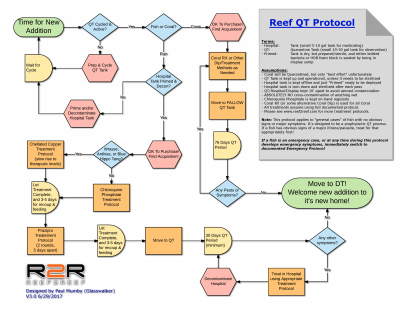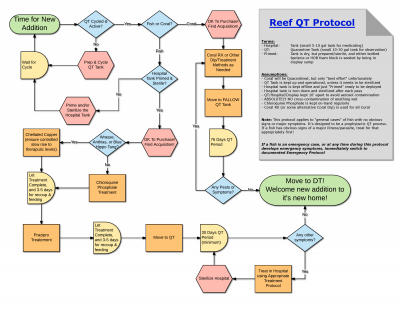- Joined
- Mar 24, 2016
- Messages
- 232
- Reaction score
- 244
Hey, I've been working on revising my intake protocol for new livestock.
Gathered some info from others on these forums, and the wealth of info from @Humblefish and @melypr1985 for example on the topic.
And based on the fact that ich/velvet seem to be running rampant right now, came up with a flowchart for my protocol. Going from the point where I decide "I would like to go looking for a new addition" through to successful completion, and prep for next round. I think I've accommodated most of the standard cases, and the every-day QT protocol. Obviously this isn't meant to be for cases where the fish is symptomatic, or an emergency case, those would require special handling. This is a prophylactic treatment protocol for all incoming fish to catch the most common stuff.
I'd love to hear any feedback/input on this.
I've yet to test this out, but will be using it very soon once my QT is back up and running (prob in next couple weeks). So would love to revise it and nail it down now.
I also plan on flowcharting out a symptomatic treatment protocol, and an emergency protocol as well.
These are mostly for myself, but hoping they can also be a great resource for the community if we can nail them down well enough.
Image is fairly large, so you might need to open it in a new tab, or click to view fullsize to read all text.
Thanks in advance for any feedback/input!

Full screenshot (for downloading or printing) here: https://www.reef2reef.com/attachments/reef-qt-protocol-v3-png.540056/
Gathered some info from others on these forums, and the wealth of info from @Humblefish and @melypr1985 for example on the topic.
And based on the fact that ich/velvet seem to be running rampant right now, came up with a flowchart for my protocol. Going from the point where I decide "I would like to go looking for a new addition" through to successful completion, and prep for next round. I think I've accommodated most of the standard cases, and the every-day QT protocol. Obviously this isn't meant to be for cases where the fish is symptomatic, or an emergency case, those would require special handling. This is a prophylactic treatment protocol for all incoming fish to catch the most common stuff.
I'd love to hear any feedback/input on this.
I've yet to test this out, but will be using it very soon once my QT is back up and running (prob in next couple weeks). So would love to revise it and nail it down now.
I also plan on flowcharting out a symptomatic treatment protocol, and an emergency protocol as well.
These are mostly for myself, but hoping they can also be a great resource for the community if we can nail them down well enough.
Image is fairly large, so you might need to open it in a new tab, or click to view fullsize to read all text.
Thanks in advance for any feedback/input!

Full screenshot (for downloading or printing) here: https://www.reef2reef.com/attachments/reef-qt-protocol-v3-png.540056/
Last edited by a moderator:




















